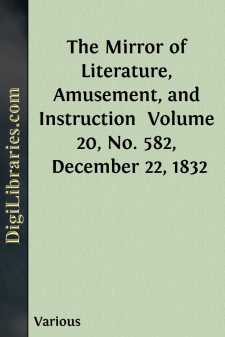Categories
- Antiques & Collectibles 13
- Architecture 36
- Art 48
- Bibles 22
- Biography & Autobiography 813
- Body, Mind & Spirit 142
- Business & Economics 28
- Children's Books 17
- Children's Fiction 14
- Computers 4
- Cooking 94
- Crafts & Hobbies 4
- Drama 346
- Education 46
- Family & Relationships 57
- Fiction 11829
- Games 19
- Gardening 17
- Health & Fitness 34
- History 1377
- House & Home 1
- Humor 147
- Juvenile Fiction 1873
- Juvenile Nonfiction 202
- Language Arts & Disciplines 88
- Law 16
- Literary Collections 686
- Literary Criticism 179
- Mathematics 13
- Medical 41
- Music 40
- Nature 179
- Non-Classifiable 1768
- Performing Arts 7
- Periodicals 1453
- Philosophy 64
- Photography 2
- Poetry 896
- Political Science 203
- Psychology 42
- Reference 154
- Religion 513
- Science 126
- Self-Help 84
- Social Science 81
- Sports & Recreation 34
- Study Aids 3
- Technology & Engineering 59
- Transportation 23
- Travel 463
- True Crime 29
The Mirror of Literature, Amusement, and Instruction Volume 20, No. 582, December 22, 1832
by: Various
Categories:
Description:
Excerpt
THE YORK COLUMN.
Five years have now elapsed since the improvements in St. James's Park were commenced, by order of Government, for the gratification of the people. We were early in our congratulation, as well as illustration, of the prospective advantages of these plans for the public enjoyment, as will be seen on reference to our tenth volume; and, with respect to the re-disposal of St. James's Park, we believe the feeling of satisfaction has been nearly universal.
At the period to which we have just alluded, the removal of Carlton House, (for it scarcely deserved the name of Palace,) had been decided on. The walls were dismantled of their decorative finery, and their demolition commenced; the grounds were, to use a somewhat grandiloquent phrase, dis-afforested; and the upper end of "the sweet, shady side of Pall Mall" marked out for public instead of Royal occupation. Thus, within a century has risen and disappeared from this spot the splendid abode and its appurtenances; for, it was in the year 1732 that Frederic, Prince of Wales, first purchased the property from the Earl of Burlington; though it was not until 1788 that the erection of Carlton House was commenced for the late King, then Prince of Wales; so that the existence of the Palace must be restricted within forty years—a term reminding us of the duration of a pavilion, rather than of a kingly mansion.
Upon the precise site of the courtyard and part of Carlton House have been erected two mansions, of splendid character, appropriated to the United Service and Athenaeum Clubs: the first built from the designs of Mr. Nash, and the latter from those of Mr. Decimus Burton. They front Pall Mall West, or may be considered to terminate Waterloo Place.
The site of Carlton House Gardens is now occupied by palatial houses, which are disposed in two ranges, and front St. James's Park. The substructure, containing the kitchens and domestic offices, forms a terrace about 50 feet wide, adorned with pillars of the Paestum Doric Order, surmounted with a balustrade. The superstructure consists of three stories, ornamented with Corinthian columns. The houses at each extremity have elevated attics. Only small portions of these superb elevations are shown in the Engraving, with the Athenaeum Club House in the distance.
In the space between the two ranges, it was proposed to erect a fountain, formed of the eight column's of the portico of Carlton House, (which was in elaborate imitation of the Temple of Jupiter Stator, at Rome,) to which eight on the same model were to be added. The balustraded terrace had been continued fronting the Park with a view to this embellishment. It however occurred to some guardian of the public weal, that the above space presented an eligible opportunity for a grand public entrance from Pall Mall into the Park. The idea was mooted in Parliament; but some difficulties arose, from the leases already granted to the builders of the houses on the terrace, who had calculated on the exclusive appropriation of the latter....












